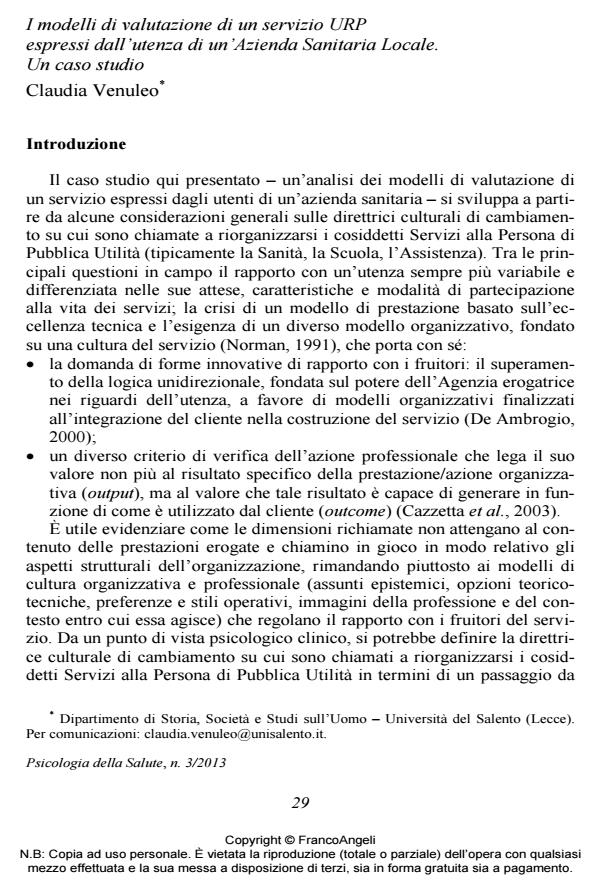The users’ models of evaluating one National Health Service Public-Relations Department. A case study
Journal title PSICOLOGIA DELLA SALUTE
Author/s Claudia Venuleo
Publishing Year 2013 Issue 2013/3
Language Italian Pages 21 P. 29-49 File size 393 KB
DOI 10.3280/PDS2013-003002
DOI is like a bar code for intellectual property: to have more infomation
click here
Below, you can see the article first page
If you want to buy this article in PDF format, you can do it, following the instructions to buy download credits

FrancoAngeli is member of Publishers International Linking Association, Inc (PILA), a not-for-profit association which run the CrossRef service enabling links to and from online scholarly content.
This paper presents a study aimed at analysing the users’ models of evaluating the Public-Relations Department (URP) settled in a Southern Italian City National Health Service (ASL). The research is grounded on a socio-constructivist and psychodynamic approach which acknowledges the social and situated nature of perceptions, opinions and attitudes expressed towards a public service, and, at the same time, their being expression of affective symbolic processes. A questionnaire constructed with ISO methodology was administered to 205 users. A Multiple Correspondence Analysis aimed to detected the factorial dimensions was applied on the data. Results highlight how user’s evaluation of the URP and of the ASL is organized by two main symbolic dimensions: the first concerns the service evaluation, depicting a dialectic between positive and critical aspects of the services. The second one concerns the model of relationship with the URP, depicted in terms of opposition between a trust and distrust one on the possibility of taking advantage from the service.
Keywords: Public-Relations Department, National Health Service, Users’ models of evaluating, symbolic dimensions, ISO Methodology
- Caring for Daughters with Anorexia Nervosa: A Qualitative Study on Parents’ Representation of the Problem and Management of the Disorder Luna Carpinelli, Tiziana Marinaci, Giulia Savarese, in Healthcare /2022 pp.1353
DOI: 10.3390/healthcare10071353 - The Meaning of Living in the Time of COVID-19. A Large Sample Narrative Inquiry Claudia Venuleo, Tiziana Marinaci, Alessandro Gennaro, Arianna Palmieri, in Frontiers in Psychology 577077/2020
DOI: 10.3389/fpsyg.2020.577077 - The COVID-19 Pandemic from the Health Workers’ Perspective: Between Health Emergency and Personal Crisis Tiziana Marinaci, Claudia Venuleo, Giulia Savarese, in Human Arenas /2023 pp.478
DOI: 10.1007/s42087-021-00232-z - Methods and Instruments in the Study of Meaning-Making Claudia Venuleo, Tiziana Marinaci, Giulia Savarese, Annalisa Venezia, pp.169 (ISBN:978-3-031-21994-8)
Claudia Venuleo, I modelli di valutazione di un servizio URP espressi dall’utenza di un’Azienda Sanitaria Locale. Un caso studio in "PSICOLOGIA DELLA SALUTE" 3/2013, pp 29-49, DOI: 10.3280/PDS2013-003002